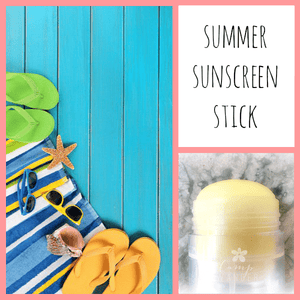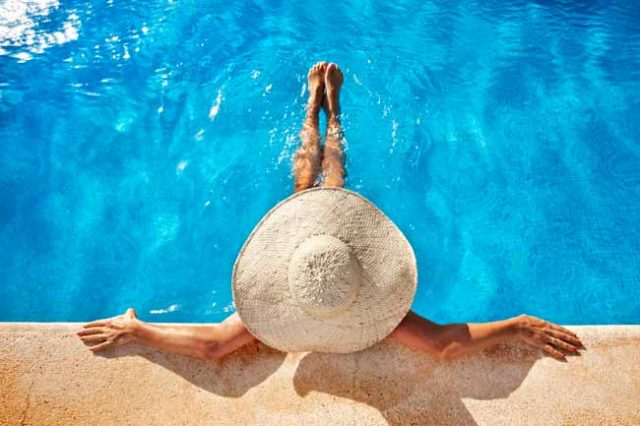Make Your Own Natural Sunscreen
May 28, 2015

This is the thing about using natural ingredients and making your own skincare products, sunscreen included. Once you find a "base" of ingredients you like the versatility will blow your mind! Find out how to transform our favorite DIY deodorant base into a safe summer sunscreen! "The shocking truth is the fact that both petrochemical sunscreens (avobenzone, methoxycinnamate, padimate-o and the like) and physical sunblocks (chemically-reacted synthetics titanium dioxide and zinc oxide) are not natural and have been found to generate free radicals when exposed to sunlight, which then can attack the nuclei of your skin cells and cause mutations. That’s right, they can cause skin cancer. Furthermore, sunscreen chemicals have been found to pass through the skin and mimic the effects of estrogen, which may disrupt the delicate balance of the body’s natural hormones." It's no surprise that many commercially made sunscreens can be more harmful than beneficial. We also know that our body needs a certain amount of sunlight to make vitamin D and convert it to D3, so what's a human to do? In my opinion, respect the sun. Know that you need it and be judicial about the amount of time you spend in it. I can't be the judge of how much sun you need or can tolerate but here are a few guidelines to think about:
- The amount of skin you expose. The more skin you expose, the more vitamin D you can produce.
- How old you are. As you get older, your skin has a harder time producing vitamin D.
- Whether you’re wearing sunscreen. Sunscreen blocks a lot of vitamin D production.
- The altitude you’re at. The sun is more intense on top of a mountain than at the beach. This means you make more vitamin D the higher up you are (at higher altitudes).
- Whether it is cloudy. Less UVB reaches your skin on a cloudy day and your skin makes less vitamin D.
- Air pollution. Polluted air soaks up UVB or reflects it back into space. This means that if you live somewhere where there is lots of pollution, your skin makes less vitamin D.
- Being behind glass. Glass blocks all UVB, so you can’t make vitamin D if you’re in sunlight, but behind glass.

Rather than relying on powerful sunscreens that may end up doing more harm than good, consider a great, wide brim hat, a lightweight shirt or ducking under some shade! Catching rays is good for you, getting sunburned is not. A natural sunscreen is good to your skin however, it won't and I repeat won't, prevent sunburn if you spend too much time in the sun! Limited exposure to the sun during a morning walk, a little gardening in the backyard, a picnic or errand running are good times to test drive a natural sunscreen, but going bare, (no sunscreen at all) and allowing healthy UVB (ultraviolet) rays to reach your skin is optimal. Just remember, once your skin is close to becoming "pink" and this will vary for all of us, apply sunscreen, cover up or find shade. I keep my natural sunscreen simple by combining ingredients that have a natural SPF and moisturize:
-
Coconut Oil - SPF 4 - 6 with moisturizing, pain-relieving and anti-inflammatory properties.
-
Shea Butter - SPF 3 - 6 full of vitamins A, Z and K.
-
Olive Oil - SPF 2 - 8 with moisturizing, with anti-inflammatory properties.
-
Rosehip Seed Oil - Considered a "dry oil" it's not greasy, doesn't sit on the surface of the skin and is deep penetrating, guarding against weathered sun damaged skin. Carrot Seed Essential Oil - Highest SPF rating of most natural ingredients! SPF 38 - 40 and rich in antioxidants and vitamins B, C, D and E. You'll need 30 drops per ounce of solid base.
-
Arrowroot Powder - is silky smooth, a natural deodorant and will absorb sweat.
-
Vitamin e oil - rich in antioxidants, a natural preservative. While I can't state a specific SPF rating I feel safe that it's a close alternative to a store bought SPF 15 sunscreen and I love knowing that what I use on my skin is beneficial vs questionable.
As I mentioned before, the beauty of an all natural base like this one creates versatility, saves money and a whole lotta time! I suggest you make the entire recipe and store it in the refrigerator. When you're ready for more sunscreen or deodorant, melt what you need, add your EOs and be on your way! {find essential oil combinations for deodorant here}. 1. Remember to keep your sunscreen in the cooler if you keep it with you. 2. Remember this sunscreen is not waterproof and will need to be reapplied often if you're swimming. 3. Remember to care about the ingredients! Check out what the Environmental Working Group has to say about your favorite brand {here}. Ready made Ultimate Deodorant Base and 1 ounce push up stick containers (as shown) are available in the CW Shop.

ingredients
- 1 cup organic, unrefined coconut oil
- 1 cup organic olive oil
- ⅔ cup organic beeswax pastilles
- ¼ cup raw organic shea butter
- 1 cup arrowroot powder
- 2 teaspoons rosehip seed oil
- 1 teaspoon vitamin e
- Carrot Seed essential oil NOTE: 30 drops per one ounce container
- one quart - wide mouth - mason jar for melting
- 1 or 2 oz deodorant sticks or jars, they'll work too!
Directions
- ONE RECIPE FILLS APPROXIMATELY {16} ONE OUNCE or {8} TWO OUNCE Containers
- Measure and add coconut oil and olive oil to a mason Jar, set the jar in three inches of hot water and set your burner to medium/low.
- Add beeswax, melt all three ingredients together slowly, stirring occasionally.
- Add shea butter, melt slowly while stirring occasionally.
- Add arrowroot powder, stir to blend.
- Add rosehip seed oil and vitamin e oil at the very end, stir to blend.
- Pour into containers of choice {30 drops carrot seed essential oil per 1 ounce of base}
- Use a larger jar for storing the solid base in the refrigerator that can be used at a later date for both Natural Sunscreen or Ultimate Deodorant Base.
- Let cool to harden, store in refrigerator.
WHEN YOU'RE READY FOR REFILLS:
- Scoop out desired amount of the refrigerated base and slowly melt it down in a mason jar water bath, add essential oils, stir and pour into desired container be it a stick or jar, let cool.
- NOTE: If you're taking your sunscreen with you, keep it in a cooler if possible as it will soften in hot weather.
Recipe By: CampWander


